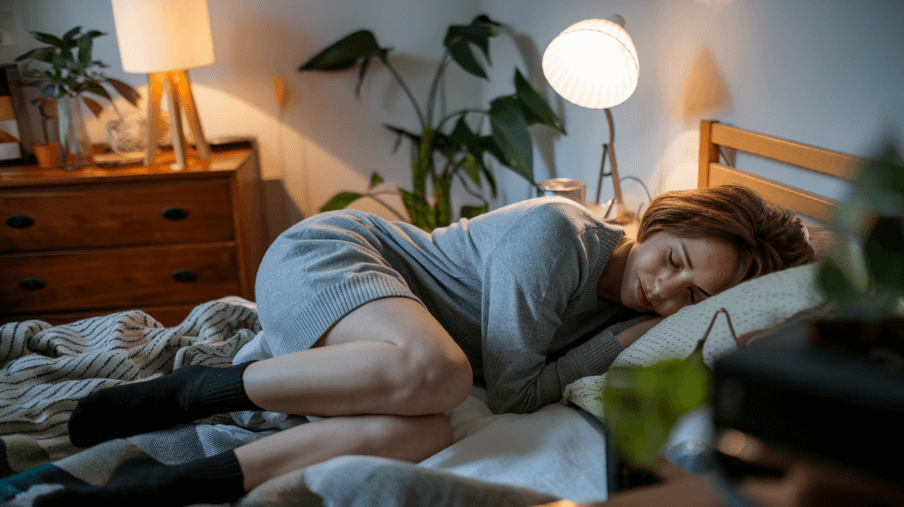15 Surprising Benefits of Sleeping With Socks On That You Should Know
Ever wondered why slipping on a pair of socks before hitting the hay could revolutionise your sleep routine? From improved circulation and better temperature regulation to enhancing relaxation, sleeping with socks might just be the bedtime hack you never knew you needed.
In this listicle, we delve into the surprising perks of keeping your toasties covered at night, explore how it can help you drift off faster, and reveal why it's worth giving this simple sleep tip a try. Scroll down for reviews of our top picks and get ready to experience a whole new level of comfort between the sheets.
1. Improved sleep quality
Wearing socks at bedtime can signal to the brain that it's time to sleep, aiding in creating a more relaxing bedtime routine. This simple addition can promote deeper sleep cycles by enhancing body temperature regulation, especially beneficial for cold sleepers. According to Healthline, maintaining an ideal sleep temperature is crucial for a refreshing night's sleep.
By keeping your feet warm with bedtime socks, you can experience a comfortable and more restful sleep. For those who struggle with restless sleep, this practice may offer significant benefits. Infants, in particular, can benefit from wearing socks to bed as they have difficulty regulating their body temperature.
Incorporating socks into your sleep routine can be a game-changer for those seeking to enhance their sleep hygiene. The additional layer of warmth provided by socks can contribute to overall comfort and relaxation, setting the stage for a good night's sleep.
2. Enhanced circulation
Keeping feet warm and comfortable by wearing socks can significantly enhance circulation in the feet and lower extremities. This simple practice helps to maintain optimal foot temperature, which is crucial for promoting healthy blood flow.
Choosing the right socks can prevent the constriction of blood vessels, allowing for unrestricted circulation. By avoiding tight or constricting socks, individuals can ensure that blood can flow freely throughout the feet, aiding in overall vascular health.
Maintaining warmth through socks acts like a foot bath, encouraging blood vessels to dilate and increasing blood flow to the extremities. This can be especially beneficial for individuals who experience cold feet or those with circulatory problems.
In colder environments, wearing socks to bed can be particularly advantageous. Studies have shown that cold feet are often a sign of poor circulation, and by wearing socks, individuals can combat this issue effectively.
3. Alleviates hot flashes
Wearing socks to bed can help alleviate hot flashes by regulating body temperature during night sweats. The socks create a more stable thermal environment, preventing sudden temperature fluctuations that can trigger hot flashes. This can provide a calming effect, reducing the intensity and frequency of hot flashes, leading to a more comfortable sleep experience.
- Socks act as insulation, keeping the feet warm and aiding in overall temperature regulation.
- Maintaining warmth in the extremities can signal the brain to dilate blood vessels, promoting heat loss and reducing the likelihood of overheating.
- Studies have shown that maintaining a consistent body temperature throughout the night can improve sleep quality and reduce disruptions caused by hot flashes.
4. Reduces symptoms of Raynaud's disease
Raynaud's disease is a condition that affects blood flow to certain parts of the body, typically the fingers and toes. Sleeping with socks on can help reduce the symptoms associated with Raynaud's disease by maintaining warmth in the extremities, which is crucial in preventing painful attacks. This simple practice can minimise exposure to cold temperatures that often trigger Raynaud's episodes, providing comfort and relief to individuals suffering from this condition.
By keeping the feet warm throughout the night, wearing socks can improve circulation and prevent blood vessels from constricting excessively due to cold temperatures. This can significantly reduce the frequency and severity of Raynaud's attacks, allowing individuals to sleep more comfortably and wake up without experiencing the discomfort typically associated with this condition.
For those with diabetes, proper foot care is essential to prevent complications such as neuropathy and poor circulation. Sleeping with socks on can help diabetic individuals maintain optimal foot temperature, reducing the risk of complications and promoting overall foot health. By incorporating this simple habit into their nightly routine, individuals with diabetes can support their overall well-being and minimise potential risks associated with the condition.
5. Helps with insomnia
Wearing socks to bed can be a simple yet effective way to tackle insomnia. By keeping your feet warm, socks help in regulating your body temperature, which is crucial for a good night's sleep. This method is recommended by many doctors as a non-invasive solution to improve sleep quality.
- Enhances Comfort: Wearing socks provides a sense of security and warmth, creating a cosy environment that signals your body it's time to rest.
- Regulates Body Temperature: Cold feet can lead to vasoconstriction, a narrowing of blood vessels that may prevent you from falling asleep. Socks help in maintaining optimal blood flow, aiding relaxation.
Studies have shown that individuals who wear socks to bed tend to fall asleep faster and experience fewer disruptions during the night. This simple practice can significantly impact your overall sleep patterns, making it easier to combat insomnia without relying on medication.
Incorporating wearing socks into your bedtime routine can serve as a soothing pre-sleep ritual, signalling to your body that it's time to unwind and prepare for rest. By addressing the anxiety often associated with cold feet, you can create a more conducive environment for relaxation and ultimately improve your sleep quality.
6. Prevents night sweats
Wearing socks to bed can prevent night sweats by helping regulate body temperature, ensuring a comfortable sleep environment.
- Socks act as a barrier against sudden temperature changes during the night, preventing overheating and excessive sweating.
- By keeping your feet warm, socks promote better blood circulation, aiding in relaxation and improved sleep quality.
Maintaining stable body temperature throughout the night is crucial for uninterrupted rest. Socks help in this by retaining heat and preventing heat loss from extremities.
- Research suggests that cold feet can disrupt sleep patterns, while wearing socks can help alleviate this issue.
- Studies show that warm feet can signal the brain to initiate sleep, leading to quicker onset of sleep and better overall sleep efficiency.
For those prone to night sweats, especially during warmer seasons or due to certain medical conditions, wearing socks can be a simple yet effective solution.
7. Boosts skin hydration
Wearing socks overnight can boost skin hydration by retaining moisture, preventing dryness, and cracking, especially during colder months. This simple bedtime routine can significantly benefit your skin health.
- Retain Moisture: By covering your feet with socks, you create a barrier that locks in the moisture produced by your skin, helping to keep it hydrated throughout the night.
- Prevent Dryness and Cracking: Dry air can strip the skin of its natural oils, leading to dryness and potential cracking. Wearing socks helps combat this issue by maintaining a moist environment for your skin.
- Enhance Effectiveness of Moisturisers: Applying moisturisers before bed and then wearing socks can enhance their effectiveness. The socks help the moisturiser penetrate deeper into the skin, providing intense hydration.
This practice is particularly beneficial for individuals with naturally dry skin or those living in regions with harsh weather conditions, where skin dehydration is a common concern.
Incorporating this simple habit into your nightly routine can lead to visibly softer and smoother skin over time. So, next time you reach for your bedtime essentials, don't forget to include a pair of comfortable socks to give your skin that extra hydration boost it deserves.
8. Reduces risk of frostbite
Wearing socks while sleeping can reduce the risk of frostbite by protecting your feet from extreme cold conditions. This simple practice helps to maintain a consistent temperature around your feet, preventing tissue damage that can occur in icy environments.
- Extra layer of insulation: Socks act as foot wraps, providing an additional barrier between your skin and the cold air. This extra layer of insulation is especially beneficial for individuals with chilly toes or those who live in colder climates.
- Preventative measure: By wearing socks, particularly toe socks or toeless socks, you can ensure that your feet stay warm throughout the night. This is crucial in avoiding the discomfort and potential health risks associated with having icy feet.
- Comfort and protection: Whether you opt for regular socks or more restrictive options like compression or rice socks, the key is to keep your feet covered. This not only enhances comfort but also shields your feet from the harsh effects of cold temperatures.
Incorporating the habit of wearing socks to bed can significantly contribute to maintaining optimal foot health, especially in unfavourable weather conditions or during colder seasons.
9. Alleviates restless leg syndrome
Wearing socks to bed can alleviate restless leg syndrome, providing warmth that soothes the legs during the night. This simple practice creates a comforting environment that reduces unnecessary leg movements, aiding in a more restful sleep experience.
Restless legs are often associated with discomfort and an uncontrollable urge to move the legs, disrupting sleep patterns. By wearing socks, individuals can support relaxation in the lower extremities, promoting better circulation and reducing the symptoms of restless leg syndrome.
In addition to the physical benefits, keeping the feet warm with socks can also have a psychological impact, signalling to the brain that it is time to relax and unwind. This sensory cue can contribute to a calmer state of mind, further enhancing the overall sleep quality.
For those struggling with restless leg syndrome, incorporating the habit of sleeping with socks on can be a simple yet effective solution. The combination of physical warmth and psychological comfort provided by socks can significantly improve sleep by addressing the discomfort and restlessness associated with this condition.
10. Eases symptoms of menopause
Sleeping with socks on can be particularly beneficial for individuals experiencing menopausal symptoms. Here's why:
- Temperature Regulation: Wearing socks helps manage the temperature fluctuations commonly associated with menopause, providing a more comfortable sleep environment.
- Comfort During Night Sweats: Socks can offer additional comfort during night sweats, a common symptom of menopause that can disrupt sleep patterns.
- Support for Restful Sleep: Amidst hormonal changes, wearing socks can contribute to a more restful night's sleep by keeping the feet warm and cosy.
By maintaining warmth at the feet, socks assist in improving overall blood circulation and promoting relaxation throughout the body. This simple practice can have a significant impact on enhancing sleep quality and alleviating discomfort caused by menopausal symptoms.
Studies have shown that maintaining optimal body temperature during sleep is crucial for uninterrupted rest, and wearing socks can play a key role in achieving this balance. For women going through menopause, this small adjustment in bedtime routine can make a noticeable difference in their sleep experience.
Incorporating the habit of sleeping with socks on as part of a bedtime ritual can provide both physical comfort and psychological reassurance during the challenging phase of menopause.
11. Enhances warmth in cold weather
Keeping your feet warm during cold nights is essential for a comfortable and restful sleep. Wearing socks to bed can significantly enhance warmth, especially in chilly weather conditions. By insulating your feet, socks help regulate your body temperature, preventing heat loss through your extremities. This simple practice can create a cosy sleeping environment, promoting better sleep quality.
Warm socks, such as those made from materials like merino wool or cashmere, provide excellent insulation and comfort. They act as a barrier against the cold, ensuring that your feet stay snug throughout the night. Pairing socks with other foot-warming methods like using blankets or a hot water bottle can further enhance the overall warming effect.
During winter months or in colder climates, cold feet can be a common issue that disrupts sleep. Wearing socks to bed is one of the right warming sleep products that can effectively combat this problem. By maintaining warmth in your feet, you are more likely to experience a deeper and more restful sleep.
Incorporating socks into your bedtime routine as part of foot-warming techniques can make a noticeable difference in how comfortably you sleep, particularly when temperatures drop. So next time you find yourself struggling to keep warm at night, consider slipping on a pair of cosy socks to help you drift off into a peaceful slumber.
12. Supports stress reduction
Enhance relaxation by keeping your feet warm with socks, which can help in reducing stress levels significantly.
Create a soothing atmosphere before bedtime by wearing socks, as the warmth around your feet promotes relaxation and signals to your body that it's time to wind down.
Alleviate tension accumulated throughout the day by allowing your feet to stay warm and cozy with socks on, aiding in stress reduction effectively.
13. Aids in faster sleep onset
Sleeping with socks on can be a simple yet effective way to improve your sleep quality. One key benefit is that it helps in aiding faster sleep onset by warming your feet. This warmth signals the blood vessels in your feet to dilate, promoting heat loss and ultimately lowering your core body temperature, which is essential for falling asleep quickly.
Another advantage of wearing socks to bed is reducing distractions caused by cold extremities. Cold feet can be uncomfortable and can keep you awake or disrupt your sleep throughout the night. By keeping your feet warm with socks, you eliminate this distraction and create a more conducive environment for restful sleep.
Moreover, research has shown that wearing socks to bed can help regulate body temperature during the night, preventing any fluctuations that could disturb your sleep. Maintaining a stable body temperature is crucial for staying asleep and achieving deep, restorative rest.
In summary, sleeping with socks on can significantly contribute to faster sleep onset, reduce disruptions from cold feet, and aid in maintaining a stable body temperature throughout the night. Consider incorporating this simple habit into your bedtime routine for a more restful and uninterrupted night's sleep.
14. Improves overall comfort
Sleeping with socks on can significantly enhance your sleeping experience by providing warmth and creating a snug atmosphere that promotes relaxation. This simple habit can help in maintaining a comfortable sleeping environment and contribute to a more restful night's sleep.
Wearing socks to bed is particularly beneficial for individuals who prefer a cosy sleeping temperature or those who are barefoot sleepers seeking extra warmth. Wearing cotton bed socks or cosy slippers can offer a sense of comfort and security, aiding in better sleep quality.
For those looking for added benefits, opting for supportive compression socks may help improve blood circulation during sleep, reducing the risk of certain foot problems and providing additional support.
Parents may find that having their children wear socks to bed can help regulate their body temperature, ensuring a peaceful night's sleep for the little ones. Various brands offer a wide range of products suitable for both adults and children, catering to different preferences and needs.
15. Reduces risk of fungal infections
Wearing clean, breathable socks to bed can significantly reduce the risk of fungal infections. By keeping your feet dry and warm throughout the night, you create an unfavourable environment for bacteria and fungi to thrive, thus safeguarding your foot health.
- Artificial fiber socks are particularly effective in maintaining proper foot hygiene as they wick moisture away from the skin, preventing excessive sweating that can lead to fungal growth.
- Ensuring your feet are covered with socks while sleeping helps regulate temperature and moisture levels, reducing the likelihood of fungal infections such as athlete's foot.
Maintaining good foot hygiene is essential for overall health and well-being. Incorporating the habit of wearing socks to bed can go a long way in preventing uncomfortable and sometimes persistent fungal issues.
Summary
Your sleep quality can significantly improve by simply wearing socks to bed. Not only does it enhance circulation and alleviate hot flashes, but it also reduces the symptoms of various conditions like Raynaud's disease and insomnia. Wearing socks to bed can help prevent night sweats, boost skin hydration, reduce the risk of frostbite, and alleviate restless leg syndrome. It even eases symptoms of menopause, enhances warmth in cold weather, supports stress reduction, aids in faster sleep onset, improves overall comfort, and reduces the risk of fungal infections.
Improve your sleep tonight by slipping on a pair of socks before bed and experience the numerous benefits they offer! Stay warm, comfortable, and supported throughout the night for a more restful and rejuvenating sleep. Remember, a simple habit like wearing socks can make a significant difference in your overall well-being.
Frequently Asked Questions
Why is sleeping with socks on beneficial for improving sleep quality?
Wearing socks to bed can help regulate body temperature, promoting better sleep by preventing heat loss through your feet. This can signal your brain that it's time to sleep, leading to deeper and more restful slumber.
How does wearing socks while sleeping enhance circulation?
Keeping your feet warm with socks aids in vasodilation, improving blood flow and circulation throughout your body, especially during sleep when circulation naturally slows down. This can help prevent cold feet and promote overall cardiovascular health.
Can sleeping with socks on alleviate hot flashes?
Yes, wearing socks to bed can help regulate body temperature, reducing the frequency and intensity of hot flashes by keeping your feet warm. This can contribute to a more comfortable and uninterrupted sleep, particularly for individuals experiencing menopausal symptoms.
Does wearing socks at night reduce the risk of fungal infections?
Indeed, sleeping with socks on creates a barrier that prevents fungus from thriving in warm and moist environments like sweaty feet. By keeping your feet dry and protected, you can lower the chances of developing fungal infections such as athlete's foot.
How does sleeping with socks on support stress reduction?
The warmth provided by wearing socks while sleeping promotes relaxation by comforting your feet and enhancing blood circulation. This physical comfort can signal your nervous system to relax, helping to reduce stress levels and contribute to a calmer state conducive to falling asleep faster.




















Leave a comment